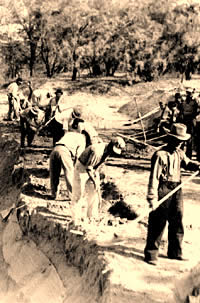
Wielding picks and long-handled shovels,
WPA workers dig through sandy Brazos River deposits
in the dusty afternoon glare at the Harrell farm. Photo
from TARL Archives.
|
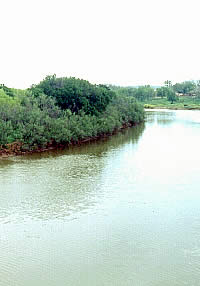
The sweet-watered Clear Fork of the
Brazos River teems with fish and other water creatures
and provides a sheltered habitat for other game along
its tree-shaded banks.
|
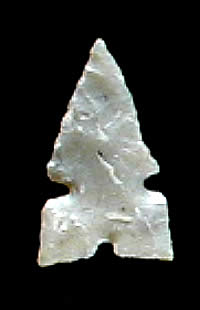
The Harrell site is the "type
site" for these small triple-notched arrow points.
Harrell points are found in Late Prehistoric sites across
north-central Texas, the Panhandle-Plains and Great
Plains area, as far north as Canada. Dating to a period
from roughly 1200 to 1500 A.D., the points were used
by Plains Villagers at the Harrell site who grew corn,
hunted buffalo, and made shell-tempered pottery vessels.
|

A slab-covered grave from the cemetery
at the Harrell site. Investigators found that many of
the burials had been carefully covered over with stones
or placed in small rock enclosures by the prehistoric
occupants at the site. Photo from TARL Archives.
|

Wild turkeys take flight over the
tree-lined river banks, a lush habitat for many types
of game. Photo courtesy Texas Parks and Wildlife Department.
|
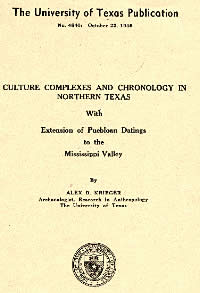
The Harrell site was one of several
examined by noted Texas archeologist Alex Krieger in
his landmark book, Culture Complexes, and Chronology
in Northern Texas, an effort to understand the chronological
relationships and contacts between cultures of the Southwest,
Plains, and the eastern United States.
|
|
The junction of the sand-choked Salt Fork, or
main branch of the Brazos River, and its sweet-watered Clear
Fork tributary in southern Young County has been a favored
place to live for at least 5,000 years. The wide curving river
terraces here provide choice spots for camping with ready
access to water, woods, and the myriad plants and animals
inhabiting the river-fringe woods and the surrounding scrubby
grasslands of the rolling plains.
The Clear Fork teemed with mussels, fish, and
waterfowl. Pecans and many other trees could be found in the
narrow woodlands lining both rivers along with deer, turkey,
and many other kinds of game. The fertile river floodplain
was suitable for agriculture, while the nearby grasslands
attracted bison and antelope. Limestone caprock along the
flat-topped hills flanking the river valley provided a ready
source of stone for building hearths and cooking ovens. The
river junction is one of many places in Texas where permanent
water and the favorable lay of the land have attracted generation
upon generation of people throughout changing times.
For thousands of years the river junction was
just another stopping place on the hunter-gatherer circuit,
a fine place to camp for a few days or weeks at a time. But
around a thousand years ago people began staying longer and
establishing villages, a pattern that intensified after A.D.
1200. The villagers raised corn and other crops along the
fertile floodplains and hunted buffalo.
In the early 1850s a remnant group of Kickapoo
Indians chose this very spot to establish a small village,
just upstream from the Brazos Indian Reservation where the
Caddo, Tonkawa, Kichai, and Waco tribes had their last refuge
in Texas. After the Kickapoo fled to Mexico and the Caddo
and other remnant Indian groups sheltered in the Brazos Reservation
were forcibly moved to Oklahoma Territory in 1859, white settlers
moved in and soon claimed all the choice land parcels along
the Brazos and its many feeder drainages. Ever since, the
Brazos River junction has been home to several generations
of farmers including the Matt D. Harrell family for whom the
site is named.
Pioneering archeological excavations at the
Harrell site in 1937-1938 found evidence of prehistoric villages
that had existed there about 500-1000 years ago as well as
traces of a great many earlier Indian camps, some buried by
up to 25 feet of mud and sand. The remains left behind by
the villagers, including bison bone hoes, corn cob fragments,
shell-tempered pottery, and diamond-shaped beveled flint knives,
represent the southernmost example of Plains Villager culture.
Between A.D. 1100-1500 corn-farming and bison-hunting
peoples lived in settled villages along the major river valleys
throughout the Southern Plains including the Texas Panhandle,
southeastern Colorado, eastern New Mexico, western Oklahoma,
and Kansas. Odd bits of Caddoan and Puebloan type pottery
and shell ornaments and tools made from materials from distant
sources show that the villagers who lived at the Harrell site
were part of an extensive, if informal, network of late prehistoric
groups linked by trade, kinship, languages, and many shared
cultural traditions.
The excavators also uncovered a small prehistoric
cemetery with the remains of 32 individuals, some buried together
in mass graves, others individually. The age of the cemetery
is uncertain, but probably dates before or at the outset of
the main period of Plains Villager occupation at the site,
about A.D. 1200-1500. Based on the arrangements of the skeletons
in the mass graves and the finding of arrow points among the
bones, it is clear that the Harrell site was once the scene
of violent events—perhaps raids from competing enemies.
Several of the skulls have faint cut marks which
may indicate scalping, a rare finding in prehistoric human
remains in Texas. Since the Harrell site was excavated, evidence
of violence has been found at dozens of Late Prehistoric sites
across the Southern Plains. Archeologists now believe that
the Late Prehistoric era was a turbulent time during which
the onset of widespread drought conditions coincided with
burgeoning populations and competition for increasingly scarce
resources such as fertile, well-watered farmland.
While fascinating and provocative, the mass
graves at the Harrell site seem to represent an unusual period
in the site's long history, a brief violent interval that
punctuated an otherwise peaceful and ordinary record of life
on the upper Brazos. The archeological excavations uncovered
all sorts of evidence of daily life including over 135 cooking
hearths—small circular arrangements of limestone rocks
that had been heated and used to bake roots and other foods.
In one area of the site a sizable burned rock
midden was found that represents one of the northernmost examples
of a pattern more common in central and southwestern Texas.
This accumulation of fire-broken limestone and sandstone rocks
is probably a specialized baking locale where basketloads
of roots were once cooked in the layered arrangements of hot
rocks, plants, and dirt known as earth ovens. Much of the
extensive evidence of hearths and baking at the Harrell site
probably predates the Plains Villager era by thousands of
years.
Understanding the Harrell site today requires
an appreciation of its archeological history. The 1937-1938
excavations were carried out under the auspices of the WPA
(Works Progress Administration), a Federal make-work program
that put the nation's unemployed back to work during the Great
Depression. At the Harrell site, one minimally trained archeologist,
George Fox, oversaw the work of dozens of unskilled laborers.
The excavations were extensive and very systematically done,
but Fox did not have the training and experience needed to
fully comprehend what he found. And while the excavations
produced many artifacts as well as extensive field notes and
records (more than 6 inches thick), a formal report was never
written.
As soon as the fieldwork was completed, the
team moved on to other sites. By 1941 World War II was underway
and the WPA program soon ended, leaving the analysis and reporting
of the Harrell site and many others unfinished. A young graduate
student from east Texas, Jack T. Hughes, wrote a Master's
thesis on the site in 1942, but he was hampered by the limitations
of the original work and by the state of archeological knowledge.
Recognizing the importance of the Harrell site,
famed archeologist Alex D. Krieger reexamined the site collection
while he was studying the prehistory of northern Texas. The
Harrell site, he thought, lay at a crossroads of sorts between
the more technically advanced moundbuilding cultures of East
Texas and the Puebloan cultures to the southwest. In his landmark
1946 treatise, Culture Complexes and Chronology in Northern
Texas, Krieger defined the Harrell site as the "type
site," or ideal example, of the Henrietta focus,
an archeological concept he applied to sites in north Texas
that had Plains Villager materials such as the pottery, bison-bone
hoes, and beveled knives. The Harrell site, he believed, was
the southernmost expression of the Plains Village tradition.
But this was before Willard Libby's discovery
of radiocarbon dating had revolutionized archeology. Krieger
had no real way of determining how old the finds at Harrell
were except by relative dating. While the chronology of the
Puebloan Southwest was comparatively well known because of
tree-ring dating, that of the mound cultures of the Southeastern
United States (including East Texas) was not yet known except
in relative terms. The archeologists of the day had only a
rudimentary understanding for how river terraces form through
time. Krieger assumed that virtually all of what was found
at the Harrell site—hearths, burials, and Plains Villager
debris—was left behind by a single culture at more or
less the same time.
Today the Harrell site remains enigmatic. It
is still one of the few intensively excavated sites in the
west-central part of north Texas, but it has never been critically
reevaluated. While some of Krieger's most important ideas
are still accepted, others are now seen as outdated or clearly
wrong. The Plains Village occupations in north Texas between
about A.D. 1200-1500 are still poorly known. Krieger's term,
the Henrietta focus, is still in use, although some believe
the concept is outdated and prefer the term, Henrietta phase
or complex. Today we realize that the archeological evidence
from the Harrell site is much more complex than the archeologists
of the 1930s and 1940s recognized and that some of its cultural
debris accumulated long before the Plains Villager era. Lacking
radiocarbon dates and other kinds of modern scientific evidence
from the Harrell site, we can only make educated guesses about
the site's human history and hope for more research in the
future.
Making sense of the past, particularly when
there appear to be influences from several different cultures,
is not an easy task. As Jack Hughes noted in his 1942 thesis,
"reconstructing the history of the part of the Brazos
on which the Harrell site is located is like trying to visualize
a motion picture on the basis of a few still photographs."
The history of the region, he noted, was complicated by the
arrival of diverse cultures bringing a variety of new traits,
by the assimilating effects of a common environment on all
these cultures, by local cultural developments, and by relationships
spawned through trade.
Despite problems of interpretation, the story
of the Harrell site's investigation and of the remarkable
finds made on the banks of the upper Brazos is well worth
telling. In the following sections, we look at the pioneering
excavations and at the evidence uncovered at the site, illustrated
in compelling black and white photographs from the WPA-era
investigations as well as more-recent color photographs of
the artifacts. We also offer a modern perspective on a site
that played an important role in the history of archeological
research.
|
|
Click on any photo below to see complete image
|
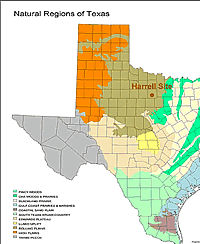
The Harrell site lies in an area
of mixed environmental resources, where the Rolling
Plains meet the Oak Woods and Prairies. The prairie
grasslands and river valley woodlands would have provided
habitat for a wide variety of animals and plants-and
ready resources for early hunters and gatherers in the
region. Map courtesy Texas Parks and Wildlife.
|
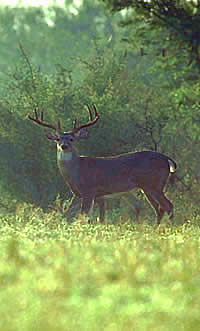
White-tailed deer were prized by
prehistoric peoples of the Brazos who ate their meat,
used their skins for clothing, and carved their large
bones into hoes and other tools. Photo courtesy Texas
Parks and Wildlife Department.
|
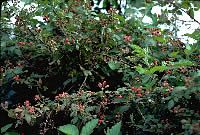
Tangles of berry vines cascade over
low hills and shrubs in the river valleys, providing
plentiful fruit in late spring. Photo courtesy Texas
Parks and Wildlife Department.
|

Bison, or buffalo, were an important
resource for the inhabitants of the Harrell site. A
single animal yielded enormous quantities of meat as
well as bone, sinew, and skin for tools, clothing, and
cover. Photo courtesy of Center for Bison Studies, University
of Montana.
|
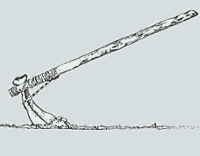
Farming implements, such as this
long-handled hoe, could be made using the scapula (shoulder
blade) or other large elements of bison and other large
mammals. (Figure redrawn by Lynet Dagel from Gilbert
L. Wilson, Agriculture of the Hidatsa Indians, copyright
1983 by the South Dakota State Historical Society. Used
with permission.)
|

Materials recovered during the extensive
WPA surveys and excavations were processed in labs such
as this one at the University of Texas. Artifacts were
washed and catalogued, vessels reconstructed, and skeletons
analyzed.
|
| |

Within a 30-mile radius of the Harrell
site, stands of hard- and softwood trees line the rivers
and cover fields and slopes, providing habitat for many
types of game. Today, much of the Harrell farm area
has been cleared for cultivation or grazing, although
it may have been more heavily wooded in earlier times.
|
|